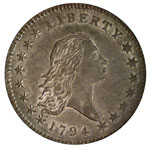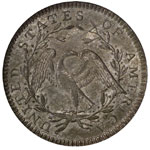
Grading Flowing Hair Half Dollars (1794-1795)

|

|
| Click to enlarge | |
Though the United States Mint was established in 1792, the inability of its coiner and its assayer to post their legally required bonds delayed the production of gold and silver coins. In March of 1794, the respective amounts of their bonds were lowered, and benefactors then stepped forth to make payment on behalf of the Mint's officers. Engraver Robert Scot set about preparing dies for the silver coins first, as deposits of that metal had already been received.
The first half dollars were delivered in October of 1794, and they featured a bust of Liberty with her long hair flowing in several locks. The central device of the reverse was a rather slim eagle perched within a simple wreath. This design continued through the summer of 1795, when production of half dollars was interrupted in favor of silver dollars and the new gold coins. When coinage of this denomination resumed, more than a year later, the Flowing Hair type was replaced with the more elaborate Draped Bust Liberty.
The mintage of 1794 half dollars was less than one-tenth that of the 1795-dated pieces, and this proportion is clearly reflected in their relative rarity. The 1794 issue is seldom selected by type collectors, as the coins dated 1795, while still scarce, are more likely to be encountered in high grades. Far more common, however, are circulated examples. The grades most often found range from Very Good to Very Fine. Anything grading Extremely Fine and higher must be considered scarce to rare. This is true of both dates but with the 1794 halves being proportionally more rare overall.
Whether one is seeking a mint state or circulated example, there are several features that may affect any coin of this type. Among these are the adjustment lines so commonly seen on early USA silver and gold. Each planchet used for these precious metal coins was weighed before striking. Planchets found to be underweight were returned to the ovens for melting, while those overweight were filed across their faces to remove the excess metal. Why the planchets were not filed on their edges to avoid scarring the finished coins remains a mystery. The result, however, was a series of parallel depressions that were only partially effaced during the striking process. A few, shallow adjustment lines will not affect the grade of a coin, as they are considered a normal part of the minting process. Numerous or very deep lines may, however, impair the aesthetic value of a coin to a degree that professional graders simply can't ignore them.
Another peculiarity of these early coins that's noticeable on both mint state and circulated examples is that they were often incompletely or irregularly struck. Portions of the design may be missing, even on high grade coins, as the result of a less than full strike or due to some deficiency in the die itself. Weakness of strike should not affect the grade of a mint state coin unless it is quite severe, but worn coins are more likely to be evaluated by the amount of detail visible. While some allowance must be made for weak or irregular striking, the type collector should always seek an example that was struck fully on a good quality planchet. Such coins, whether worn or uncirculated, are few and far between.
As is always true of early U. S. coins, beware of pieces that have been improperly cleaned, have had damage repaired or have had their details touched up by an engraver. Such coins are more common than one would suspect, and collectors are urged to seek certified examples whenever possible. Problem coins are not without value, of course, and these may be submitted to NGC for details grading, which omits a numeric grade and includes a brief description of the problem condition.
From One to Seventy originally ran in The Numismatist, official publication of the American Numismatic Association (www.money.org)
Enjoy the article? Use the bookmark tool to save or share it.
![]()
Return to the Coin Grading Guide - From 1 to 70
